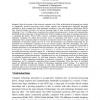Free Online Productivity Tools
i2Speak
i2Symbol
i2OCR
iTex2Img
iWeb2Print
iWeb2Shot
i2Type
iPdf2Split
iPdf2Merge
i2Bopomofo
i2Arabic
i2Style
i2Image
i2PDF
iLatex2Rtf
Sci2ools
TIS
2010
2010
Cultivating Interaction Ubiquity at Work
: Since the invention of the electronic computer in the 1940s, technological development has resulted in dramatically increased processing power, storage capacity and communication bandwidth physically embedded in devices ranging from large mainframe computers to tiny radio-frequency identification (RFID) tags. Toasters, blenders, elevators, cars and an increasing range of other everyday objects embed computer technology. Over 4.3 billion phone connections have placed processing power, storage and communication bandwidth directly in the hands of around half of the World's population and a range of emerging technologies is expanding this further. Weiser (1991) created a conceptual clearing characterising this phenomenon as ubiquitous computing. He argued that pervasive access to information will lead to a more harmonious relationship where computing adapt to the human environment instead of the opposite. However, large-scale mobilisation of interaction implies the risk of a less th...
| Added | 22 May 2011 |
| Updated | 22 May 2011 |
| Type | Journal |
| Year | 2010 |
| Where | TIS |
| Authors | Carsten Sørensen |
Comments (0)

